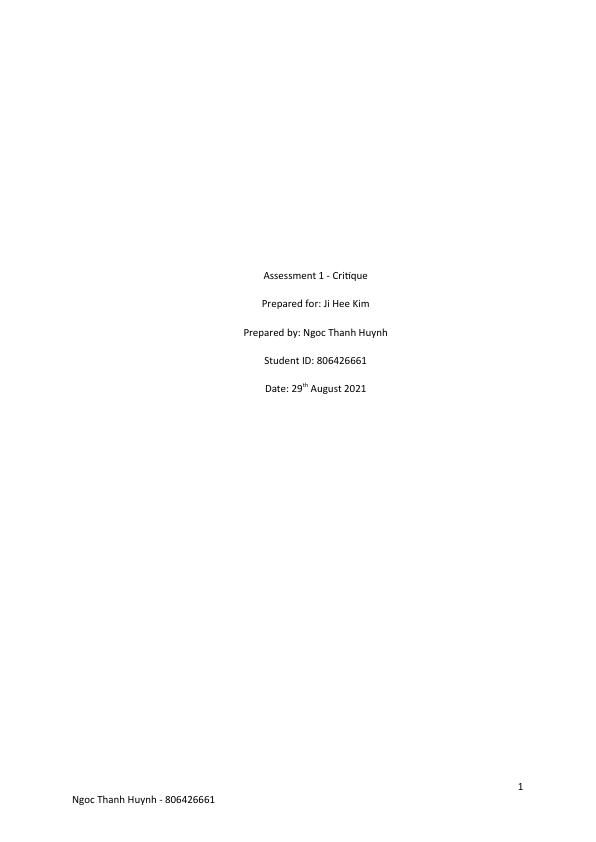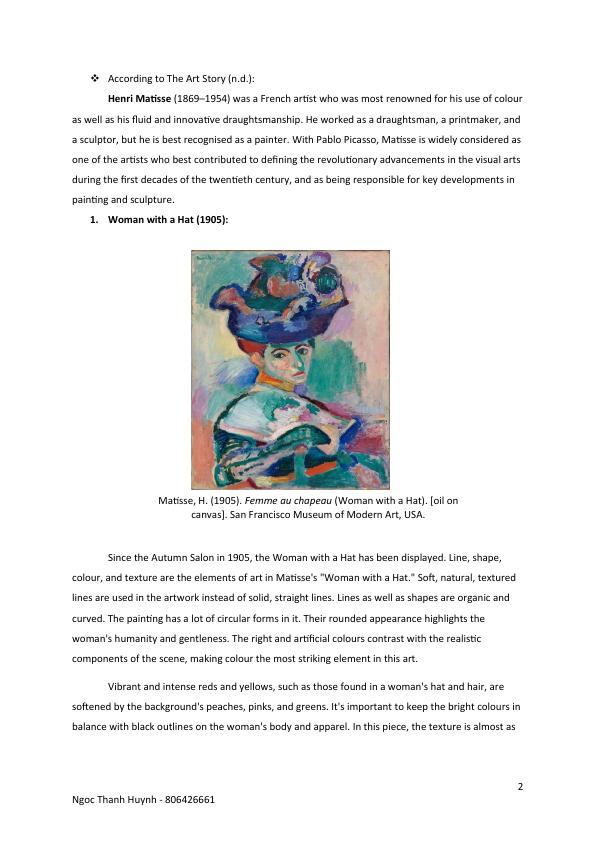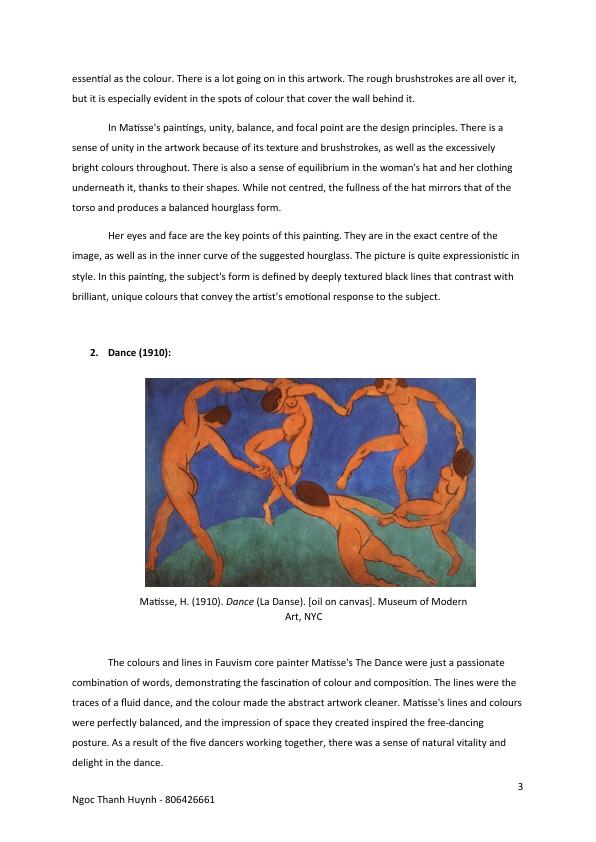The Critique Assessment 2022
7 Pages1980 Words9 Views
Added on 2022-04-04
The Critique Assessment 2022
Added on 2022-04-04
ShareRelated Documents
Assessment 1 - Critique
Prepared for: Ji Hee Kim
Prepared by: Ngoc Thanh Huynh
Student ID: 806426661
Date: 29th August 2021
1
Ngoc Thanh Huynh - 806426661
Prepared for: Ji Hee Kim
Prepared by: Ngoc Thanh Huynh
Student ID: 806426661
Date: 29th August 2021
1
Ngoc Thanh Huynh - 806426661

According to The Art Story (n.d.):
Henri Matisse (1869–1954) was a French artist who was most renowned for his use of colour
as well as his fluid and innovative draughtsmanship. He worked as a draughtsman, a printmaker, and
a sculptor, but he is best recognised as a painter. With Pablo Picasso, Matisse is widely considered as
one of the artists who best contributed to defining the revolutionary advancements in the visual arts
during the first decades of the twentieth century, and as being responsible for key developments in
painting and sculpture.
1. Woman with a Hat (1905):
Since the Autumn Salon in 1905, the Woman with a Hat has been displayed. Line, shape,
colour, and texture are the elements of art in Matisse's "Woman with a Hat." Soft, natural, textured
lines are used in the artwork instead of solid, straight lines. Lines as well as shapes are organic and
curved. The painting has a lot of circular forms in it. Their rounded appearance highlights the
woman's humanity and gentleness. The right and artificial colours contrast with the realistic
components of the scene, making colour the most striking element in this art.
Vibrant and intense reds and yellows, such as those found in a woman's hat and hair, are
softened by the background's peaches, pinks, and greens. It's important to keep the bright colours in
balance with black outlines on the woman's body and apparel. In this piece, the texture is almost as
2
Ngoc Thanh Huynh - 806426661
Matisse, H. (1905). Femme au chapeau (Woman with a Hat). [oil on
canvas]. San Francisco Museum of Modern Art, USA.
Henri Matisse (1869–1954) was a French artist who was most renowned for his use of colour
as well as his fluid and innovative draughtsmanship. He worked as a draughtsman, a printmaker, and
a sculptor, but he is best recognised as a painter. With Pablo Picasso, Matisse is widely considered as
one of the artists who best contributed to defining the revolutionary advancements in the visual arts
during the first decades of the twentieth century, and as being responsible for key developments in
painting and sculpture.
1. Woman with a Hat (1905):
Since the Autumn Salon in 1905, the Woman with a Hat has been displayed. Line, shape,
colour, and texture are the elements of art in Matisse's "Woman with a Hat." Soft, natural, textured
lines are used in the artwork instead of solid, straight lines. Lines as well as shapes are organic and
curved. The painting has a lot of circular forms in it. Their rounded appearance highlights the
woman's humanity and gentleness. The right and artificial colours contrast with the realistic
components of the scene, making colour the most striking element in this art.
Vibrant and intense reds and yellows, such as those found in a woman's hat and hair, are
softened by the background's peaches, pinks, and greens. It's important to keep the bright colours in
balance with black outlines on the woman's body and apparel. In this piece, the texture is almost as
2
Ngoc Thanh Huynh - 806426661
Matisse, H. (1905). Femme au chapeau (Woman with a Hat). [oil on
canvas]. San Francisco Museum of Modern Art, USA.

essential as the colour. There is a lot going on in this artwork. The rough brushstrokes are all over it,
but it is especially evident in the spots of colour that cover the wall behind it.
In Matisse's paintings, unity, balance, and focal point are the design principles. There is a
sense of unity in the artwork because of its texture and brushstrokes, as well as the excessively
bright colours throughout. There is also a sense of equilibrium in the woman's hat and her clothing
underneath it, thanks to their shapes. While not centred, the fullness of the hat mirrors that of the
torso and produces a balanced hourglass form.
Her eyes and face are the key points of this painting. They are in the exact centre of the
image, as well as in the inner curve of the suggested hourglass. The picture is quite expressionistic in
style. In this painting, the subject's form is defined by deeply textured black lines that contrast with
brilliant, unique colours that convey the artist's emotional response to the subject.
2. Dance (1910):
The colours and lines in Fauvism core painter Matisse's The Dance were just a passionate
combination of words, demonstrating the fascination of colour and composition. The lines were the
traces of a fluid dance, and the colour made the abstract artwork cleaner. Matisse's lines and colours
were perfectly balanced, and the impression of space they created inspired the free-dancing
posture. As a result of the five dancers working together, there was a sense of natural vitality and
delight in the dance.
3
Ngoc Thanh Huynh - 806426661
Matisse, H. (1910). Dance (La Danse). [oil on canvas]. Museum of Modern
Art, NYC
but it is especially evident in the spots of colour that cover the wall behind it.
In Matisse's paintings, unity, balance, and focal point are the design principles. There is a
sense of unity in the artwork because of its texture and brushstrokes, as well as the excessively
bright colours throughout. There is also a sense of equilibrium in the woman's hat and her clothing
underneath it, thanks to their shapes. While not centred, the fullness of the hat mirrors that of the
torso and produces a balanced hourglass form.
Her eyes and face are the key points of this painting. They are in the exact centre of the
image, as well as in the inner curve of the suggested hourglass. The picture is quite expressionistic in
style. In this painting, the subject's form is defined by deeply textured black lines that contrast with
brilliant, unique colours that convey the artist's emotional response to the subject.
2. Dance (1910):
The colours and lines in Fauvism core painter Matisse's The Dance were just a passionate
combination of words, demonstrating the fascination of colour and composition. The lines were the
traces of a fluid dance, and the colour made the abstract artwork cleaner. Matisse's lines and colours
were perfectly balanced, and the impression of space they created inspired the free-dancing
posture. As a result of the five dancers working together, there was a sense of natural vitality and
delight in the dance.
3
Ngoc Thanh Huynh - 806426661
Matisse, H. (1910). Dance (La Danse). [oil on canvas]. Museum of Modern
Art, NYC

End of preview
Want to access all the pages? Upload your documents or become a member.
Related Documents
Art Movements | Art Historylg...
|6
|1208
|49
Art Analysis of Three Paintingslg...
|5
|882
|484
